1979 Lincoln Versailles: Compact Luxury
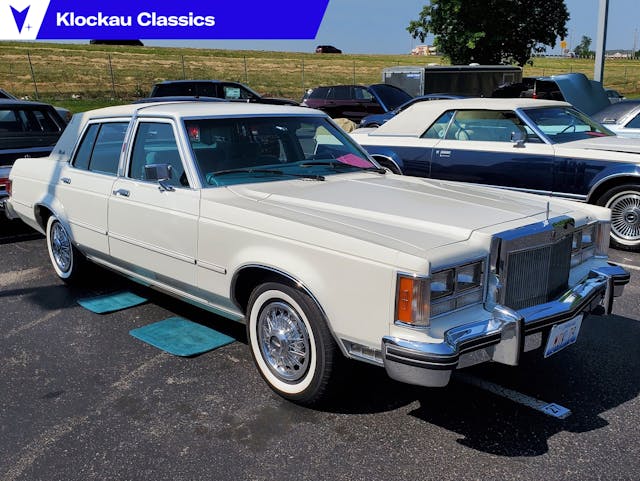
I’m one of those people who likes—in some cases, loves—cars that most folks love to hate. Cadillac Cimarrons, Mustang II Ghias, Plymouth Volate Premier woody wagons. Yep. Love ’em. And Gremlins, and Matador Barcelona sedans. And the Lincoln Versailles, that late-1970s “luxury compact” that 99 percent of internet know-it-alls love to hate. Be warned. This is not going to be a column full of cheap shots and Granada references. Buckle up!
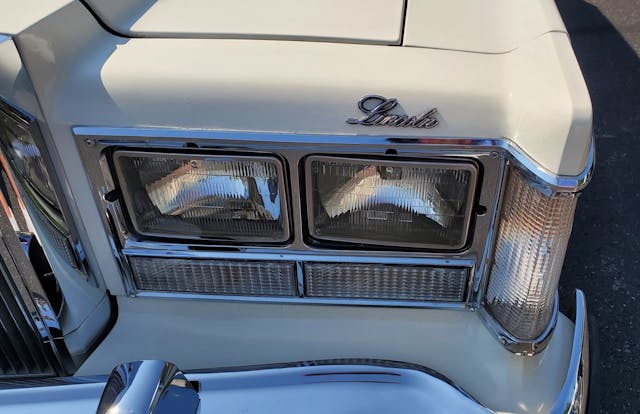
The Versailles was a step in a new direction for Lincoln. Until its appearance as a 1977 model, all Lincolns were big. Really big. True, the Mark III, which appeared in 1968 as a ’69 model, was based on the Thunderbird, but it was still pretty good sized. And imposing in its own right. But the Versailles was a different type of Lincoln.
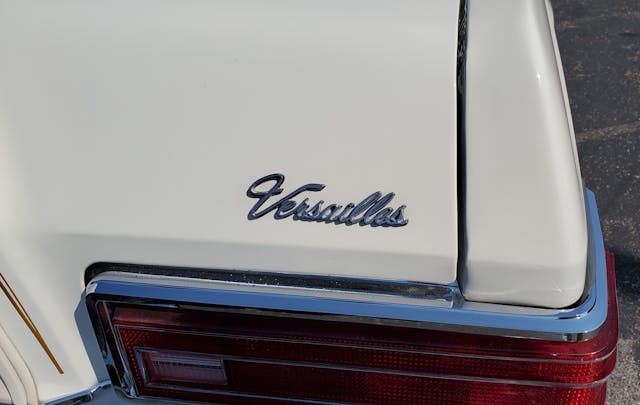
And yes, let’s get it out of the way: It WAS based on the “premium compact” Ford Granada and Mercury Monarch. But so what? Plenty of luxury cars were—and are—based on more prosaic chassis. The primary issue was that it still looked so much like a Granada or Monarch—at first.

Of course, the Versailles came about due to the appearance in 1975 of the all-new 1976 Cadillac Seville, the first small Cadillac. Now there’s another car that armchair enthusiasts love to claim is “just a Nova.” Psst. It’s not. But let’s not get into that today, shall we?
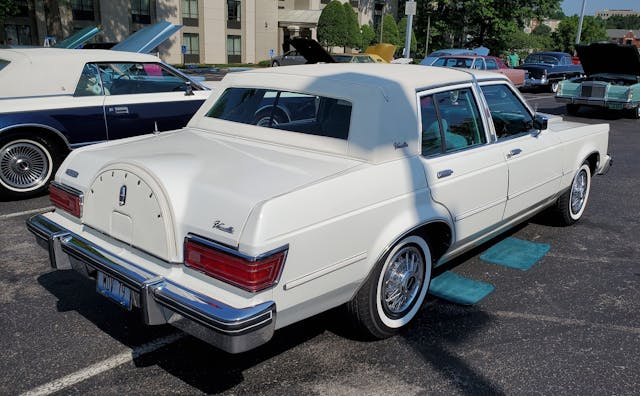
But yes, partly due to Cadillacs and Lincolns getting so super-sized by the ’70s, and also partly due to increasing interest in luxury European imports, both luxury makes decided to offer a smaller car. Smaller, but still with all the luxury trappings: power everything, full- or landau-style padded vinyl roofs, wire wheel covers, opera/coach lamps, velour or leather seating, and anything else commonly seen on domestic luxocruisers at the time.
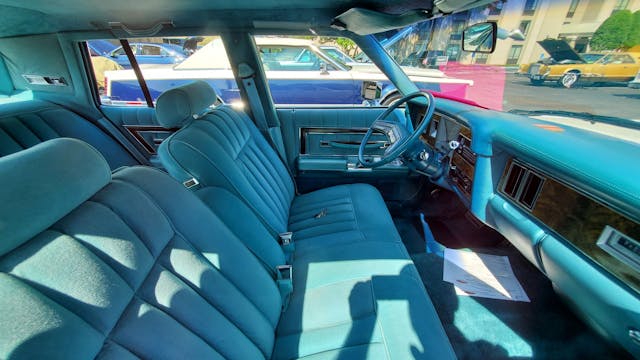
Despite its Granada origins, Lincoln offered a lot of interesting additional features to the Versailles. It was the first U.S. car with halogen-sealed-beam headlamps, four-wheel power disc brakes (at a time when many domestic cars still had front disc/rear drum braking), and a programmable garage door opener built into the driver’s side sun visor. By the way, do you know what U.S car was the first with basecoat/clearcoat paint? Yes, it was the Versailles!

Sales were initially tepid. Price was likely a factor, as the initial ’77 model started at $11,500 (about $58,409 today). That same year you could get a new Continental sedan—a car that was MUCH larger and roomier and imposing—for $9636 ($48,942). Sales were 15,434, and 1978 was even worse. The price was bumped to $12,529 ($59,146), and only 8931 were sold.
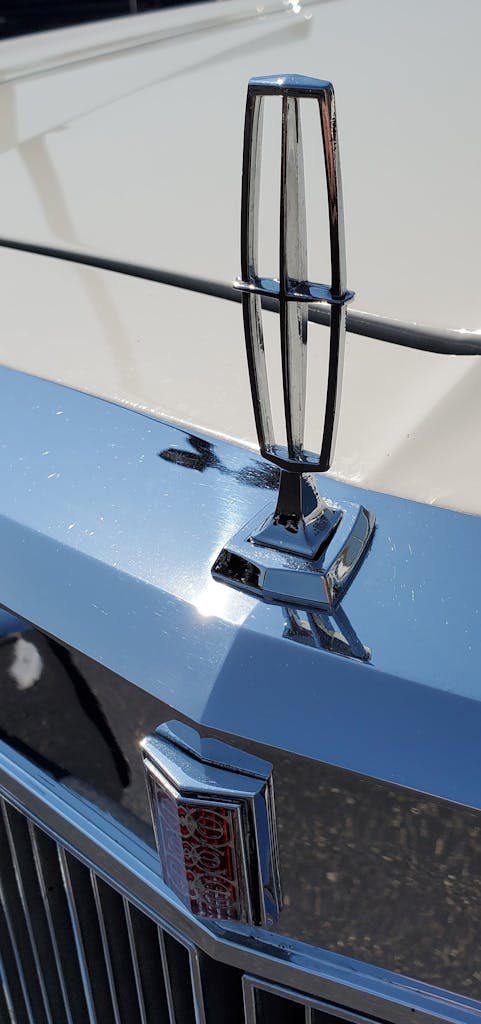
But in 1979, some money was spent to spruce up the Versailles and make it more distinctive. The biggest change was the roofline. Initially identical to Granada Ghias in the suburbs and plain-Jane versions in government fleets, it was made more formal for ’79 with a fat C-pillar and a new standard Cavalry twill vinyl half-roof. An even-thicker padded coach roof was also available as an option. This immediately made the Versailles look more like a separate entity, though of course the basic body and 109.9-inch wheelbase remained unchanged.
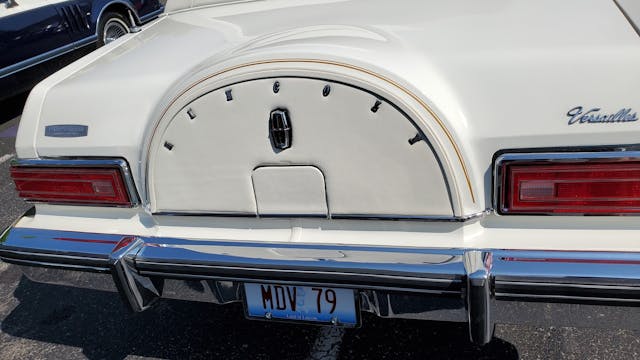
The 1979 Lincoln Versailles had a base price of $12,939 ($54,842), weighed in at 3684 pounds, and 21,007 were built for the model year—a healthy improvement from 1978, when less than 9000 were sold. All came with Ford’s robust 302-cubic-inch V-8, with a 4.00 x 3.00 bore and stroke and 130 horsepower, and SelectShift automatic transmission. Standard equipment was ample and included automatic climate control, AM/FM stereo with 8-track player, forged aluminum wheels (yes, the wire wheel covers were extra, as seen on this example), cruise control, and a Cartier-signed electronic digital clock.
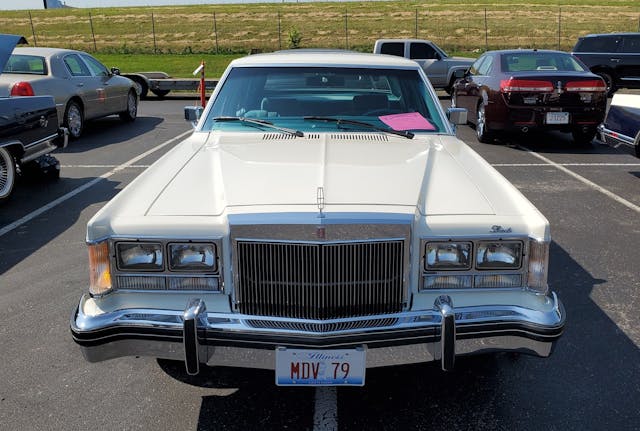
The new roofline was likely the biggest reason the Versailles’ nearly tripled its sales numbers over 1978. It now looked much more like a Lincoln. But it was still pricier than the big Continental sedan and coupe, which based at $11,200 ($47,483) and $10,985 ($46,571), respectively. The Mark V personal luxury coupe was the only model with a higher base price than the Versailles, at $13,067 ($55,398).
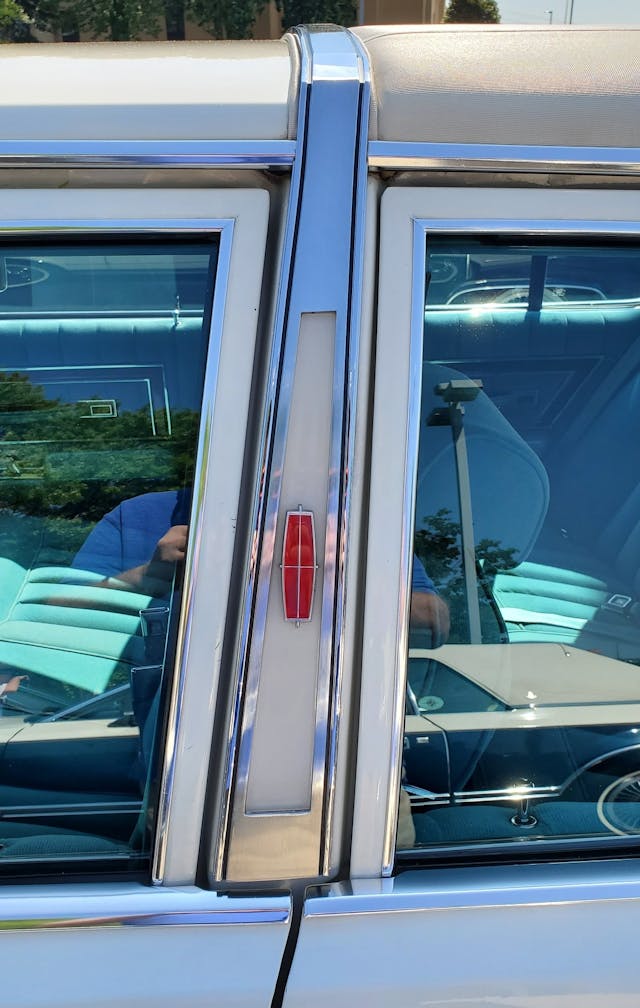
It was a great sales year for the Versailles, but it didn’t last. In 1980 it was virtually unchanged except for a couple of new colors and a base price increase to $14,674 ($54,812). The drop may have been partly due to the Continentals and Mark being downsized and now being much closer to the Versailles’s size. At any rate, only 4784 were built for ’80 and it would not return for 1981, though the Fox-body based 1982 Continental would essentially replace it in size and position in the Lincoln model lineup.
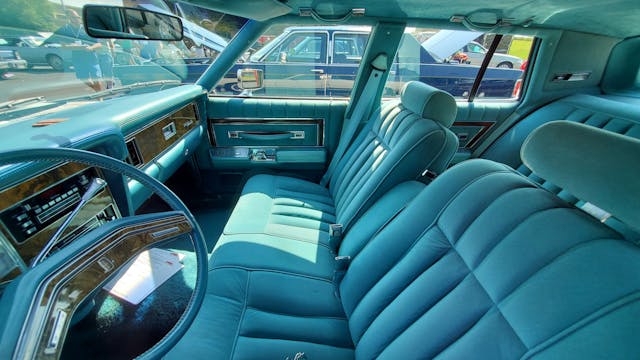
This particular Versailles, finished in white with an amazing aqua velour interior, was seen by my friend Jayson Coombes at the LCOC Eastern Meet held in Knoxville, Tennessee, in June. I loved the color combo and its seemingly showroom condition. As Jayson related, there weren’t a giant amount of cars there, but they were all quality cars, and he saw some extremely nice stuff.
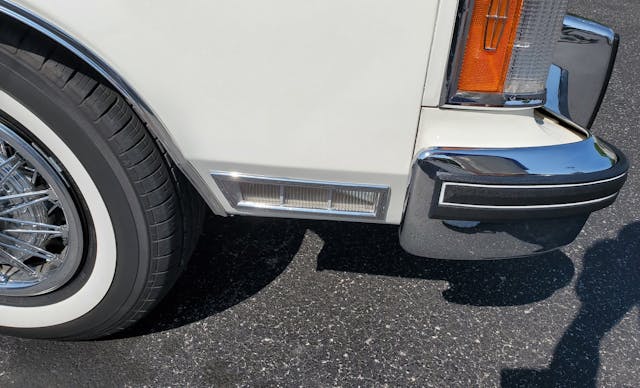
In addition to this Versailles, there was a gorgeous 1968 Continental sedan, 1949 Cosmopolitan fastback sedan, Fiesta Red ’64 Continental convertible, and more. I expect at least a few of those other show entries will appear here sooner or later.
As always, I’d like to thank Jayson for allowing me to use his photos. You’re a gentleman and a scholar!

***
Check out the Hagerty Media homepage so you don’t miss a single story, or better yet, bookmark it. To get our best stories delivered right to your inbox, subscribe to our newsletters.


I believe Lincoln figured if Cadillac could price the Seville as the second most expensive offering just below the gargantuan Fleetwood Limo/9 Passenger Sedan that they could price the Versailles likewise. However if you were in a Lincoln showroom in 1977-1978 the difference in not only size between the not downsized Town Car and the Versailles was night and day. Not to mention the traditional Lincoln customer, much like Tom, demanded area wide velour and 20 feet steam to stern. As Tom pointed out with the new for 1980, Introduced in mid calandra year 1979, downsized Town Car the Versailles looked more at ease, and sales improved as Tom said it did not look so much like a fleet issued Ford. Great car Jason found, and from Grand Rapids, guess it was not driven in winter.
Wonderful articles and photos , thank you. Good choice for a review. And thank you for offering “the unloved” for special mention. Traditional American cars have been replaced by tiny jellybeans and cubes, so “the unlovely” stand out now in a different and ever better way.
And thanks for the hat tip to the “woody” Volare wagon.
Thank you for mentioning the new roof for 1979. I described this change to someone once and they thought I’d lost my mind.
The 1977 Versailles could be had with a 351. Things under the hood were crowded, making them hard to work on. Generally, they were reasonably reliable-typical wear items, driveability issues common to the era, honeycomb catalytic converters that would melt internally-was pretty much it as far as problems. And power steering control valves. The Versailles (along with its Falcon/earlyMustang/Maverick/Granada relatives) used a power assist system attached to the steering linkage. When the control valve went bad, it would power back and forth (left/right) without steering input from the driver. The more slop in the linkage the worse it was, to the point it was tough to keep the car in a single traffic lane. Thankfully a simple and relatively inexpensive fix, once properly diagnosed.
I was a young, “sophisticated car” snob back then, and wanted nothing to do with the Versailles and cars of its ilk. Now I recognize how cool they really were.
The formal roof of this Versailles adds much to the elegant look (much like the 80S RWD FIFTH AVENUES). Once was a passenger in a Versailles and found it comfortable and smooth. But for me the larger Town Cars were much better in size and OTT excess. Have had 78 Town Coupe, 89 Signature, and current 2007 Signature Limited. Last of the TRADITIONAL American Luxury sedans! LINCOLN…what a Luxury car should be!
Cool Looking Car I Had The Pleasure Of Owning A 1978 Lincoln Versailles White On White Purchased At The Lincoln Dealership In Torrance California In 1985
I’m still amazed something like this survives in Illinois. I would have expected it to rust to death.
That interior would make me smile every time I got in it. Love it. A 2 door version with the front end down about 2.5 inches and the back about 1.5 inches… that would be cool.
De gustibus non est disputandum. I recognize and honour your passion!
Selling Lincolns in the early 70’s was easy. When the Versailles came along, many saw it for what it was…A gussied up Granada. Until I read this article did I realize it looks as if Lincoln lifted those headlamp doors directly from an 80’s Chryco 5th Avenue or a Dodge Diplomat. Maybe it was the other way around seeing as the versailles debuted before the slimmed down 5th Avenues.
Pure kitsch.
Being a total Ford man, I tried very hard to like the Versailles, but I just couldn’t help think Ford really didn’t have their hart into it. Being an American car Gearheads, we all know how the Big Three would use the base platform car to produce various models by messing with the front and rear ends, and different trim levels. We Gearheads always knew that under the skins they were the same car. There was nothing knew about that. Of course we knew that the Versailles was a “gussied up Granada/Monarch, and they were akin to the famous Ford Falcon. If the platform was good, I see nothing wrong with that, in fact it makes sense. That’s if the platform is good. As one of the other commenter’s mentioned. The front suspension and power steering gear on the Falcon platform had seriously flawed front suspension and power steering issues. I had a 69 Mach l, that I loved so much all my friends knew I wanted to be burried in it when I died. I was always chasing power steering issues. The power steering control valve was mounted to the left side of the drag link. It had a stud sticking out of it to mount it to the drag link, when the steering wheel was turned it would put pressure on the stud, and that would engage the p/s hydrolics to ease the steering effort. Problem was there was to much play in the control valve to drag link. I could wiggle the steering wheel back an forth about a half inch in each direction with the stud in the control valve not making contact with the drag link. I hated that! I must have replaced the control valve 7 times and it was always the same poor fit. Next was the front coil springs were mounted above the top A arms. It might have worked on the Falcon that only had inline 6 engines, and the weight of the Falcon was much less than the 69 Mach l. My Mach had a 351 Windsor V8, with power front disk brakes,and rear drums. It had A/C, and I always put wider tires on it thinking it would track better. It didn’t. What it did do was amplify all the front end problems, and add to them. The additional heft of the larger tires, the sloppy coil spring placement and the hinky control valve mounting it would also wear out idler arms on a regular basis. The steering was so loose the left side of the control valve had wear marks ground into it from the left tie rod rubbing against it on left turns. True Story! But I loved the car so much I put up with it. In 1979, Ford invested millions fitting rack and pinion steering, first on the 79 Fairmonts, and later in the Mustangs of the Fox Platform. Ford also went to modified Macpherson front struts. Ford went from having the worst front ends to having the best switching to the Fox Platform. Now back to the Versailles. On the exterior, the grill and headlights fit together very well. It gave the Versailles a very Lincolnesck look about it, however, the rear was a mess. The Lincoln spare tire hump was OK, but the taillights dud nor work at all. Ford didn’t pull them from some parts bin because those taillights were never used on any other Ford. For the interior, it was very nice everything was done very well, they used quality materials and it looked rich and cmhad Full-size Lincoln comfort. If Ford modified the exterior sheet metal more so the first thing you saw was a Granada, the Versailles could have done much better, proved by the improvement of the C pillars and the roofline paid off. The Seville was a Nova, we all knew that, but it didn’t look like one. I believe that with a more modified exterior, the Versailles could have kicked the Seville’s ass, just like the Town Cars did to the devilles. It just shows to go ya, that some times you got it, and sometimes you don’t. Now in my opinion, the 1982 Continentals were gorgeous and elegant. The front ends were totally Lincoln. The Bussel backs too. Lincoln did a much better job than Cadillac with the “BB” I typically don’t like 2 tone paint, but the black and maroon, and even the dark gray and maroon really fit the car perfectly. But In 83 Lincoln changed the headlights to resemble a more Ford corporate look, and that didn’t work nearly as much as the 82 fronts. I also liked the 82 Thunderbirds, most people don’t, but I sure did. I love American cars and there have always been models I really loved, and others not so much. But I will tell you, now that I’m much older, some if not most of the cars that I referred to in the not so much category, I now see them much more attractive. It could be our likes and dislikes change as we age,which may be true. However, I think the real reason is how excruciatingly boring and non-discript today’s cars are. Most of the foreign cars look like used bars of soap, and are all the same boring colors, different shades of gray, made of plastic. And I for one have seen enough SUVs to make me want to vomit. Back in the Golden Age of American Cars, there was styling, there were colors and there was tons and tons of chrome. I love the late 50s and 60s cars that had personally, so much so, they became part of the family, and as well they should. Check out just the taillights alone, they are so intense, I can still just love staring at them. Now the Big Three have stopped building sedans and our beloved station wagons. Detroit says people don’t like sedans and wagons so they stopped building them. I submit that Detroit stopped building them because there are more restrictions on sedans to make government imposed fuel requirements on the cars, but not the trucks.Thats right, we’re all driving trucks and SUVs because it works better for Detroit, not us. Next is the EVs and autonomous cars. I love the sound of the exhaust of a V8, and I still love driving. I just hope I’m dead by the time that takes over. Yikes!